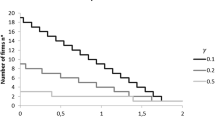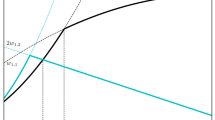Abstract
We present a model where technology transfer (TT) is embedded into a non cooperative model of utility and profit maximization and is the result of an endogenous matching process between technology transfer offices and innovative firms. We show that TT strictly depends on the costs of searching researchers and firm advertising for vacant projects. In this scenario, technology progress might be excessively low if technology transfer offices search for project matches too much intensively. The result occurs because both sides of the market ignore the externalities of their decisions. Complementarity or substitutability between the tightness in the TT market and the technology stock are both potential equilibrium outcomes.





Similar content being viewed by others
Notes
The other countries selected are: France, Germany, Japan, and United Kingdom. See World Economic Forum (2015) for a detailed description of the scores and ranking reported for each country. Calcagnini et al. (2015) discuss about the role of TT as one of the deep determinants of the TFP growth of European countries.
Theoretical models of TT often referred either to the triple helix approach or to the linear model of innovation. The former uses an evolutionary framework to study the relationship among universities, industry and government (Leydesdorff 2000). The latter postulates that innovation starts with basic research, followed by applied research and development, and it eventually ends with production and diffusion (Godin 2006). However, this traditional view recently changed in favor of a microfoundation approach of the relationship among the three main actors of innovation. Barney and Felin (2013) focus on the matching between individuals and organizations, while Cunningham et al. (2015) study the factors that induce researchers to become a principal investigator. They labelled the influencing factors as push (project dependencies and institutional pressures) and pull (control, career ambition and advancement) factors. Further, recent empirical microfounded TT models give a great attention to the analysis of the aggregation, capability development, joint production motivation and value creation (Barney and Felin 2013; Foss and Lindenberg 2013; Winter 2013).
In more general settings, other TTO’s functions are to help researchers to license inventions or to start spin off companies.
We label as TTP any possible way through which the knowledge created in universities might be transferred to firms. In general, the prevailing way is through licensing agreements; the other way involves the creation of spin-offs. See Macho-Stadler and Prez-Castrillo (2010) for a discussion.
A complete “Mathematical Appendix” is available upon request from the authors.
We assume that even there is heterogeneity among TTOs, researchers and firms, an average behavior is prevailing in the non cooperative Nash equilibrium. See Sect. 2 of the “Mathematical Appendix”.
In a principal-agent setting, Jensen and Thursby (2001) assume that TTO’s objective is to maximize a weighted average of the expected utilities of the university (administration) and researcher (inventor).
Following the increasing recognition of a ’third mission’, most TTOs receive public financial resources from their parent university. TTOs can also draw upon a mix of funds resulting from their activities, namely a share of the capital gains on firms’ equity participation, a share of net royalties on licensed technology, and an overhead on collaborative research agreements (OECD 2011).
Bozeman (2000) recognizes the active role of governments and universities in technology development and transfer. Governments act as producers of research, supplying applied research and technology to industry, or as brokers who design policies for industrial technology development and innovation. Thus, public policies are crucial to fostering U–I cooperation. Recently, Muscio et al. (2016) identify three classes of institutionally-defined rules that can motivate faculty members to establish a spinoff company. These are: general rules and procedures; rules regulating monetary incentives; rules related to the entrepreneurial risk.
See Sect. 3 of the “Mathematical Appendix”.
As for other model parameters, we assume an average bargaining power parameter \(\beta \) common to all TTOs. Of course, characteristics of TTOs vary significantly both within and across institutional and national contexts. Thus, different bargaining power might characterize the distribution of surplus between firms and TTOs in each matching.
In Italy \(\beta \) is approximatively equal to 10%, i.e.: the 10% of the surplus generated by a TT project is gained by the university.
See Kochenkova et al. (2015) for a systematic review of academic studies on public policy measures in support of technology transfer.
References
Aristei, D., Vecchi, M., & Venturini, F. (2015). University and inter-firm R&D collaborations: propensity and intensity of cooperation in Europe. The Journal of Technology Transfer, 41, 841–871. https://doi.org/10.1007/s10961-015-9403-1.
Audretsch, D. B., & Lehmann, E. E. (2005). Do university policies make a difference? Research Policy, 34, 343–347. https://doi.org/10.1016/j.respol.2005.01.006.
Audretsch, D. B., Lehman, E. E., & Warning, S. (2005). University spillover and new firm location. Research Policy, 34, 1113–1122. https://doi.org/10.1016/j.respol.2005.05.009.
Banal-Estañol, A., Macho-Stadler, I., & Pérez-Castrillo, D. (2017). Endogeneous matching in university–industry collaboration: Theory and empirical evidence from the UK. Management Science, 64(4), 1591–1608. https://doi.org/10.1287/mnsc.2016.2680.
Barney, J., & Felin, T. (2013). What are microfoundations? Academy of Management Perspectives, 27(2), 138–155. https://doi.org/10.5465/amp.2012.0107.
Blanchard, 0. J., & Diamond, P. A. (1989). The beveridge curve. Brookings Papers on Economic Activity, 1, 1–76.
Bozeman, B. (2000). Technology transfer and public policy: A review of research and theory. Research Policy, 29, 627–655. https://doi.org/10.1016/S0048-7333(99)00093-1.
Braunerhjelm, P., Acs, Z. J., Audretsch, D. B., & Carlsson, B. (2010). The missing link: Knowledge diffusion and entrepreneurship in endogenous growth. Small Business Economics, 34(2), 105–125. https://doi.org/10.1007/s11187-009-9235-1.
Calcagnini, G., Giombini, G., & Travaglini, G. (2015). The productivity gap among European countries. In Working papers in economics, mathematics and statistics WP 15/10. University of Urbino Carlo Bo.
Calcagnini, G., Favaretto, I., Giombini, G., Perugini, F., & Rombaldoni, R. (2016a). The role of universities in the location of innovative start-ups. The Journal of Technology Transfer, 41, 670–693. https://doi.org/10.1007/s10961-015-9396-9.
Calcagnini, G., Giombini, G., Liberati, P., & Travaglini, G. (2016b). A matching model of university–industry collaborations. Small Business Economics, 46, 31–43. https://doi.org/10.1007/s11187-015-9672-y.
Calcagnini, G., & Travaglini, G. (2014). A time series analysis of labor productivity. Italy versus the European countries and the U.S. Economic Modelling, 36, 622–628. https://doi.org/10.1016/j.econmod.2013.02.020.
Castillo, F., Gilless, J. K., Heiman, A., & Zilberman, D. (2016). Time of adoption and intensity of technology transfer: An institutional analysis of offices of technology transfer in the United States. The Journal of Technology Transfer, 43, 120–138. https://doi.org/10.1007/s10961-016-9468-5.
Conte, A., & Vivarelli, M. (2014). Succeeding in innovation: Key insights on the role of R&D and technological acquisition drawn from company data. Empirical Economics, 47, 1317–1340. https://doi.org/10.1007/s00181-013-0779-1.
Cunningham, J., O’Reilly, P., O’Kane, C., & Mangematin, V. (2015). At the frontiers of scientific advancement: The factors that influence scientists to become or choose to become publicly funded principal investigators. The Journal of Technology Transfer, 41, 778–797. https://doi.org/10.1007/s10961-015-9400-4.
Diamond, P. A. (1982). Aggregate demand management in equilibrium. Journal of Political Economy, 90(5), 881–894.
European Commission. (2013). Knowledge transfer study 2010–2012. In: Final report. Luxembourg: Publications Office of the European Union.
Foss, N. J., & Lindenberg, S. (2013). Microfoundations for strategy: A goal framing perspective on the drivers of value creation. Academy of Management Perspectives, 27(2), 85–102. https://doi.org/10.5465/amp.2012.0103.
Geuna, A., & Muscio, A. (2009). The governance of university knowledge transfer: A critical review of the literature. Minerva, 47, 93–114.
Godin, B. (2006). The linear model of innovation: The historical construction of an analytical framework. Science, Technology and Human Values, 36(6), 639–667. https://doi.org/10.1177/0162243906291865.
Jensen, R., & Thursby, M. (2001). Proofs and prototypes for sale: The licensing of university inventions. The American Economic Review, 91(1), 240–259.
Jensen, R. A., Thursby, J. G., & Thursby, M. C. (2003). Disclosure and licensing of university inventions: The best we can do with the \({\text{ s }}^{\ast \ast }\)t we get to work with. International Journal of Industrial Organization, 21(9), 1271–1300.
Kanama, D., & Nishikawa, K. (2015). What type of obstacles in innovation activities make firms access university knowledge? An empirical study of the use of university knowledge on innovation outcomes. The Journal of Technology Transfer, 42, 141–157. https://doi.org/10.1007/s10961-015-9459-y.
Kochenkova, A., Grimaldi, R., & Munari, F. (2015). Public policy measures in support of knowledge transfer activities: a review of academic literature. The Journal of Technology Transfer, 41, 407–429. https://doi.org/10.1007/s10961-015-9416-9.
Lach, S., & Schankerman, M. (2004). Royalty sharing and technology licensing in universities. Journal of the European Economic Association, 2(2–3), 252–264. https://doi.org/10.1162/154247604323067961.
Leyden, D. P., & Link, A. N. (2013a). Collective entrepreneurship: The strategic management of research triangle park. In D. P. Audretsch & M. L. Walshok (Eds.), Creating competitiveness: Entrepreneurship and innovation policies for growth (pp. 176–185). MA: Northampton.
Leyden, D. P., & Link, A. N. (2013b). Knowledge spillovers, collective entrepreneurship, and economic growth: The role of universities. Small Business Economics, 41, 797–817. https://doi.org/10.1007/s11187-013-9507-7.
Leydesdorff, L. (2000). The triple helix: An evolutionary model of innovations. Research Policy, 29(2), 243–255.
Link, A. N., & Scott, J. T. (2005). Universities as partners in US research joint ventures. Research Policy, 34(3), 385–393. https://doi.org/10.1016/j.respol.2005.01.013.
Link, A. N., Siegel, D. S., & Bozeman, B. (2007). An empirical analysis of the propensity of academics to engage in informal university technology transfer. Industrial and Corporate Change, 16(4), 641–655. https://doi.org/10.1093/icc/dtm020.
Link, A. N., & Welsh, D. H. B. (2013). From laboratory to market: On the propensity of young inventors to form a new business. Small Business Economics, 40(1), 1–7. https://doi.org/10.1007/s11187-011-9345-4.
Macho-Stadler, I., & Prez-Castrillo, D. (2010). Incentives in university technology transfers. International Journal of Industrial Organization, 28(4), 362–367.
Macho-Stadler, I., Prez-Castrillo, D., & Veugelers, R. (2007). Licensing of university inventions: The role of a technology transfer office. International Journal of Industrial Organization, 25(3), 483–510.
Meoli, M., Paleari, S., & Vismara, S. (2013). Completing the technology transfer process: M&As of science-based IPOs. Small Business Economics, 40(2), 227–248. https://doi.org/10.1007/s11187-012-9416-1.
Muscio, A., Quaglione, D., & Ramaciotti, L. (2016). The effects of university rules on spinoff creation: The case of academia in Italy. Research Policy, 45, 1386–1396. https://doi.org/10.1016/j.respol.2016.04.011.
Muscio, A., Quaglione, D., & Vallanti, G. (2015). University regulation and university–industry interaction: A performance analysis of Italian academic departments. Industrial and Corporate Change, 24, 1047–1079.
Netval (2015). Protagonisti dell’ecosistema dell’innovazione? Dodicesimo rapporto Netval sulla valorizzazione della ricerca nelle università e negli enti pubblici italiani. Pavia, Italia: Università degli Studi di Pavia.
OECD. (2011). OECD innovation policy platform. Paris: Technology Transfer Offices.
Perkmann, M., Tartari, V., McKelvey, M., Autio, E., Brostro, A., D’Este, P., et al. (2013). Academic engagement and commercialisation: A review of the literature on university–industry relations. Research Policy, 42, 423–442. https://doi.org/10.1016/j.respol.2012.09.007.
Phan, P. H., & Siegel, D. S. (2006). The effectiveness of university technology transfer. Foundations and Trends in Entrepreneurship, 2(2), 77–144.
Pissarides, C. (1984). Search intensity, job advertising, and efficiency. Journal of Labour Economics, 1(2), 128–144.
Pissarides, C. (1986). Unemployment and vacancies in Britain. Economic Policy, 3, 499–559.
Pissarides, C. (2000). Equilibrium unemployment theory (2nd ed.). Cambridge: MIT Press.
Shi, S., & Wen, Q. (1997). Labor market search and capital accumulation: Some analytical results. Journal of Economic Dynamic and Control, 21, 1747–1776.
Siegel, D. S., Waldman, D., & Link, A. (2003). Assessing the impact of organizational practices on the relative productivity of university technology transfer offices: An exploratory study. Research Policy, 32, 27–48. https://doi.org/10.1016/S0048-7333(01)00196-2.
Solow, R. (1979). Another possible source of wage stickness. Journal of Macroeconomics, 1, 79–82.
Winter, S. G. (2013). Habit, deliberation, and action: Strengthening the microfoundations of routines and capabilities. Academy of Management Perspectives, 27(1), 120–127. https://doi.org/10.5465/amp.2012.0124.
World Economic Forum. (2015). The global competitiveness report 2014–2015, (Full Data edn). World Economic Forum: Geneva
Yu, G. J., & Lee, J. (2016). When should a firm collaborate with research organizations for innovation performance? The moderating role of innovation orientation, size, and age. The Journal of Technology Transfer, 42, 1451–1465. https://doi.org/10.1007/s10961-016-9469-4.
Author information
Authors and Affiliations
Corresponding author
Electronic supplementary material
Below is the link to the electronic supplementary material.
Rights and permissions
About this article
Cite this article
Calcagnini, G., Giombini, G., Liberati, P. et al. Technology transfer with search intensity and project advertising. J Technol Transf 44, 1529–1546 (2019). https://doi.org/10.1007/s10961-018-9667-3
Published:
Issue Date:
DOI: https://doi.org/10.1007/s10961-018-9667-3




